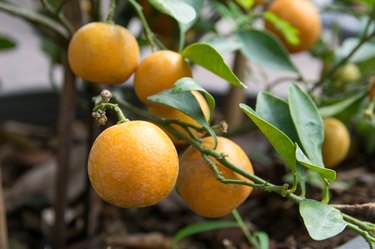
Oranges contain ascorbic acid, also known as vitamin C. Other acids that contribute to the nutritional profile of oranges include folic, pantothenic, hydroxycinnamic, citric, malic and oxalic. This citrus fruit packs a nutritional punch that makes it an excellent addition to most diets; however, the amount of acid in oranges can irritate some people with sensitive stomachs.
Ascorbic Acid
Video of the Day
Your body does not store vitamin C, so you have to replace it daily. Eating one orange gives you a full day's recommended dose of Vitamin C. Ascorbic acid aids healthy cell growth for making skin, blood vessels, muscles and cartilage. It is essential for healthy bones and healing damaged tissue. Ascorbic acid helps fight heart disease, cancer and arthritis. If you do not get enough vitamin C each day, you become susceptible to high blood pressure, bleeding gums, dry skin, bruising and plaque in your blood vessels.
Video of the Day
Folic Acid
Folic acid, more commonly known as vitamin B or folate, builds your cells and makes red blood cells. It also helps prevent strokes, heart disease and colon cancer. Folic acid is water-soluble, which means your body loses it every day through urine, so you must replace it from the food you eat. During pregnancy, it is important to eat foods rich in folic acid to prevent neurological birth defects and cleft palate in babies.
Pantothenic Acid
Vitamin B5, known as pantothenic acid, helps your body change the carbohydrates you eat into glucose for energy. You need to replace pantothenic acid every day, and it is essential for adrenal gland function, producing red blood cells and keeping your digestive tract healthy. If you do not take in enough pantothenic acid, you may be tired, depressed, irritable and develop respiratory problems.
Hydroxycinnamic Acids
Hydroxycinnamic acids are phytochemicals that help your immune system fight cancer and heart disease. You can obtain hydroxycinnamic acids by eating citrus fruits, like oranges, in your daily diet.
Citric Acid
Citric acid, found in all citrus fruits, adds the sour taste to lemons, limes, grapefruit and oranges. Citric acid is added to other food products, such as candy, soda and juice, to make them taste sour. Its acidic quality makes it useful as a preservative for canned foods and preserving meat. Another use for citric acid is as a household cleaner.
Malic Acid
Oranges, apples, rhubarb, tomatoes, peaches and cherries are a few of the fruits that contain malic acid. Malic acid crystals are used as a flavoring in wine; they also are used as preservatives for ice cream, frozen juices, baked goods and fruit preserves.
Oxalic
Orange leaves contain oxalic acid. Too much oxalic acid in your body contributes to the development of kidney stones and gallstones. The acid combines with your body's calcium and metals to form crystals, and it also slows the absorption of calcium in your body.
- Food and Agriculture Organization: Nutritional and Health Benefits of Citrus Fruits
- Hawkins Watts: Natural Acids of Fruits and Vegetables
- University of Maryland Medical Center: Vitamin C (Ascorbic Acid)
- West Virginia University Extension: Folic Acid
- University of Maryland Medical Center: Vitamin B5 (Pantothenic Acid)
- The Kitchen: What’s the Deal with Citric Acid?
- New York University Langone Medical Center: Malic Acid